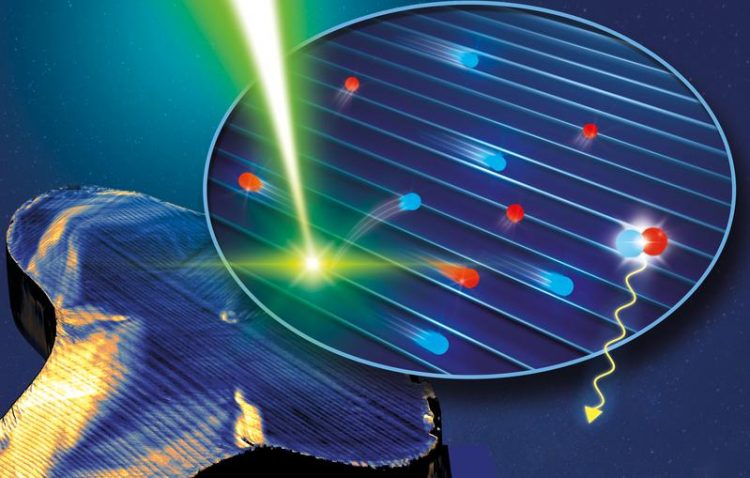Electrons in the fast lane

Along microscopic structures in perovskite solar cells electrons can move faster. © MPI-P
Solar cells convert sunlight into electricity. During this process, the electrons of the material inside the cell absorb the energy of the light. Traditionally, this light-absorbing material is silicon, but perovskites could prove to be a cheaper alternative.
The electrons excited by the sunlight are collected by special contacts on the top and bottom of the cell. However, if the electrons remain in the material for too long, they can lose their energy again. To minimize losses, they should therefore reach the contacts as quickly as possible.
Microscopically small structures in the perovskites – so-called “ferroelastic twin domains” – can influence how fast the electrons move. An international research group led by Stefan Weber at the Max Planck Institute for Polymer Research in Mainz discovered this phenomenon.
The stripe-shaped structures that the scientists investigated form spontaneously during the fabrication of the perovskite by mechanical stress in the material. By combining two microscopy methods, the researchers were able to show that electrons move much faster parallel to the stripes than perpendicular to them. “The domains act as tiny highways for electrons,” compares Stefan Weber.
For their experiments, the researchers first had to visualize the stripe-shaped domains. They succeeded in doing this with a piezo force microscope (PFM). Five years ago, Weber and his colleagues discovered the domains for the first time in a perovskite crystal using this method.
“Back then, we already wondered whether the structures had an influence on the operation of a perovskite solar cell,” Weber explains. “Our latest results now show that this is the case.”
The breakthrough came when the researchers compared their PFM images with data obtained from another method called photoluminescence microscopy. “Our photoluminescence detector works like a speed trap,” explains Ilka Hermes, researcher in Weber's group and first author of the study.
“We use it to measure the speed of electrons in different directions at the microscopic level.” Hermes discovered that along the stripes the electrons moved about 50 to 60% faster than perpendicular to them. “If we were able to make the stripes point directly to the electrodes, a perovskite solar cell could become much more efficient,” concludes Hermes.
The researchers have now published their results in the journal “Energy Environmental Science”. With the new results, not only solar cells could be improved. Other optoelectronic applications such as light-emitting diodes or radiation detectors could also benefit from directed charge transport.
“In general, it is an advantage if we can direct the electrons in the right direction,” explains Stefan Weber. The researchers' idea: to put perovskite crystals under mechanical stress during their production. This so-called “strain engineering” would enable an optimized orientation of the electron highways.
Jun.-Prof. Dr. Stefan Weber
webers@mpip-mainz.mpg.de
lka M. Hermes, Andreas Best, Leonard Winkelmann, Julian Mars, Sarah M. Vorpahl, Markus Mezger, Liam Collins, Hans-Jürgen Butt, David S. Ginger, Kaloian Koynov, Stefan A. L. Weber: Anisotropic carrier diffusion in single MAPbI3 grains correlates to their twin domains
(Energy & Environmental Science); https://dx.doi.org/10.1039/D0EE01016B
Media Contact
More Information:
https://www.mpip-mainz.mpg.de/en/press/pr-2020-07All latest news from the category: Power and Electrical Engineering
This topic covers issues related to energy generation, conversion, transportation and consumption and how the industry is addressing the challenge of energy efficiency in general.
innovations-report provides in-depth and informative reports and articles on subjects ranging from wind energy, fuel cell technology, solar energy, geothermal energy, petroleum, gas, nuclear engineering, alternative energy and energy efficiency to fusion, hydrogen and superconductor technologies.
Newest articles

NASA: Mystery of life’s handedness deepens
The mystery of why life uses molecules with specific orientations has deepened with a NASA-funded discovery that RNA — a key molecule thought to have potentially held the instructions for…

What are the effects of historic lithium mining on water quality?
Study reveals low levels of common contaminants but high levels of other elements in waters associated with an abandoned lithium mine. Lithium ore and mining waste from a historic lithium…

Quantum-inspired design boosts efficiency of heat-to-electricity conversion
Rice engineers take unconventional route to improving thermophotovoltaic systems. Researchers at Rice University have found a new way to improve a key element of thermophotovoltaic (TPV) systems, which convert heat…



